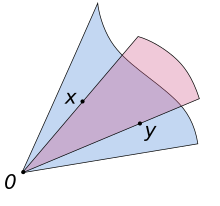
Back Konvexer Kegel German Cono convexo Spanish مخروط محدب FA Cône convexe French 凸錐 Japanese Convexe kegel Dutch Stożek wypukły Polish Выпуклый конус Russian Опуклий конус Ukrainian Nón lồi VI

In linear algebra, a cone—sometimes called a linear cone for distinguishing it from other sorts of cones—is a subset of a vector space that is closed under positive scalar multiplication; that is, is a cone if implies for every positive scalar . A cone need not be convex, or even look like a cone in Euclidean space.
When the scalars are real numbers, or belong to an ordered field, one generally calls a cone a subset of a vector space that is closed under multiplication by a positive scalar. In this context, a convex cone is a cone that is closed under addition, or, equivalently, a subset of a vector space that is closed under linear combinations with positive coefficients. It follows that convex cones are convex sets.[1]
In this article, only the case of scalars in an ordered field is considered.
- ^ Boyd, Stephen; Vandenberghe, Lieven (2004-03-08). Convex Optimization. Cambridge University Press. ISBN 978-0-521-83378-3.



